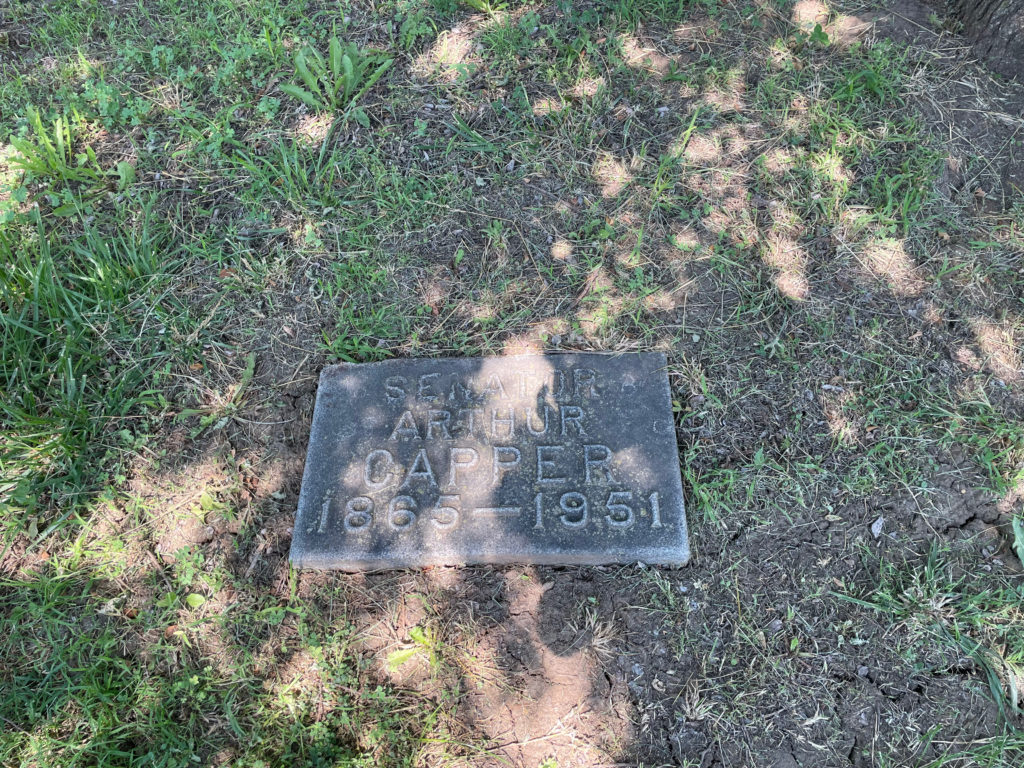Erik Visits an American Grave, Part 942
This is the grave of Arthur Capper.

Born in 1865 in Garnett, Kansas, Capper went to public school and started working in the newspaper industry at the age of 14 as a printer’s devil. He became a typesetter at the Topeka Daily Capital after he graduated from high school and quickly worked his way up the Kansas newspaper world. He became an editor at the paper and then the paper’s correspondent in Washington. This put the political bug in him. In 1892, he married the daughter of the governor of Kansas and then he started buying up newspapers after a brief stint with the New York Tribune. He soon had a media empire in the state to the point that he got national attention as a leader in the nation’s newspaper industry. The Capital was known for its fine reporting that was often picked up by other papers.
In 1912, Capper decided to go into politics full time. He ran for governor. But that was not a great year for Republicans, even in a Republican state such as Kansas and he lost the race. Two years later however, he did win and then he won reelection in 1916. His particular interest was, not surprisingly, agriculture. He already had been president of the Board of Regents of what later became Kansas State University, the state’s land grant institution. So agricultural modernization and development was his bag. He also led the way nationally for motion picture censorship, making this a theme of his leadership. He claimed “As long as certain classes of moving picture houses, disreputable poolrooms and other amusement enterprises cater to depraved taste, as long as immoral books and suggestive songs are within the reach of our high school pupils,” the need to censor movies and other popular entertainments.
Kansas had term limits for two terms as governor. So Capper went on to the Senate in 1918. He not surprisingly was on Committee on Agriculture and Forestry. He was the co-sponsor of the Capper-Volstead Act, which gave personhood to agricultural corporations to limit antitrust legislation against agriculture. This was a central desire of the nation’s agricultural lobby and also went a long ways to developing an organized farm bloc in Congress. Still, for a Republican, he wasn’t too reactionary on economic issues. He was involved in administering Washington D.C. and was the lead senator behind the Alley Dwelling Authority, which was a pioneering government program to develop Washington’s alleys, which became the first federal housing authority in the country. He later had a housing project named after him in Washington.
On the other hand, Capper was as terrible on race as the standard white elite of the period. In fact, he attempted to put forward a constitutional amendment to ban mixed-race marriages. Ah, the fear of miscegenation. In any case, this led to such outrage from the nation’s Black community that the Senate wouldn’t touch it and Capper had to withdraw it. Oddly though, he was involved in the Kansas NAACP and opposed the showing of Birth of a Nation in his state. Moreover, his parents were abolitionists. It seems that he simply wanted to make marriage law uniform throughout the nation, realized he couldn’t get such a law through the South without banning interracial marriage, and so betrayed his previous beliefs. No credit to him though, none at all. He also was one of the major eugenicists in Congress. In fact, one organization issues Capper awards for the ideal eugenic family.
Capper also had a reputation as a massive blowhard. Some called him a demagogue. He was noted as an excellent public speaker, not to mention as a writer due to his journalism background. He was also a strong prohibitionist.
Capper also became a sharp isolationist as the nation moved toward World War II. He hated the entire idea of intervention in Europe, all the way to the point of Pearl Harbor, when he was still pretty sketchy on it. He wasn’t quite as loud about it as Hiram Johnson and Gerald Nye, but he was still pretty awful on it. In 1943, Isaiah Berlin, who was in the U.S. analyzing the nation’s politics for the British Foreign Office, wrote of Capper: “a solid, stolid, 78-year-old reactionary from the corn belt, who is the very voice of Mid-Western “grass root” isolationism. A newspaper proprietor who was once described as contriving to sit on the fence and keep both ears on the ground at the same time. Like Johnson and Nye, an unwavering opponent of all the Administration’s foreign policies, including reciprocal trade.”
In 1946, Capper finally became the chair of the Senate Agriculture Committee. But he was 81 and in decline. He was nearly deaf by this time. Nonetheless, he decided he needed to learn to fly and did so, taking lessons. How someone can fly while not being able to hear the instructions of air traffic controllers, I do not know. Maybe things were different than the 1940s. In any case, Capper did not run for reelection in 1948. He returned to Kansas to run his regional media empire. He died there in 1951. He was 86 years old.
Arthur Capper is buried in Topeka Cemetery, Topeka, Kansas.
If you would like this series to visit other senators who were elected in 1918, you can donate to cover the required expenses here. Augustus Owsley Stanley is in Frankfort, Kentucky (his grandson was the legendary LSD chemist Owsley Stanley) and Furnifold Simmons is in New Bern, North Carolina. Previous posts in this series are archived here.


